Metonitazene
Metonitazene is an analgesic drug related to etonitazene, which was first reported in 1957,[1] and has been shown to have approximately 100 times the potency of morphine by central routes of administration,[2], but if used orally it has been shown to have approximately 10 times the potency of morphine[3].
 | |
| Identifiers | |
|---|---|
IUPAC name
| |
| CAS Number | |
| PubChem CID | |
| Chemical and physical data | |
| Formula | C21H26N4O3 |
| Molar mass | 382.464 g·mol−1 |
| 3D model (JSmol) | |
SMILES
| |
InChI
| |
Its effects are similar to other opioids like fentanyl and heroin, including analgesia, euphoria, sleepiness[3]. Adverse effects include vomiting, and respiratory depression that can potentially be fatal. Because of high dependency potential and dangerous adverse effects it has never been introduced in pharmacotherapy.
See also
References
- Hunger, A.; Kebrle, J.; Rossi, A.; Hoffmann, K. (1957-10-15). "[Synthesis of analgesically active benzimidazole derivatives with basic substitutions]". Experientia. 13 (10): 400–401. doi:10.1007/bf02161116. ISSN 0014-4754. PMID 13473817.
- Hunger, A.; Kebrle, J.; Rossi, A.; Hoffmann, K. (1960). "Benzimidazol-Derivate und verwandte Heterocyclen III. Synthese von 1-Aminoalkyl-2-nenzyl-nitro-benzimidazolen". Helvetica Chimica Acta. 43 (4): 1032–1046. doi:10.1002/hlca.19600430412. ISSN 0018-019X.
- Bromig, G. (1958-10-15). "[New powerful analgetics and their clinical testing]". Klinische Wochenschrift. 36 (20): 960–963. doi:10.1007/bf01486702. ISSN 0023-2173. PMID 13612082.
This article is issued from
Wikipedia.
The text is licensed under Creative
Commons - Attribution - Sharealike.
Additional terms may apply for the media files.